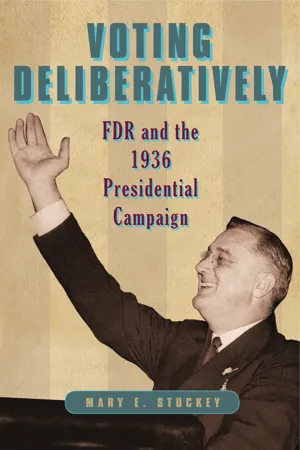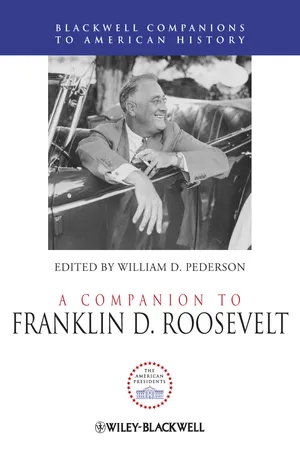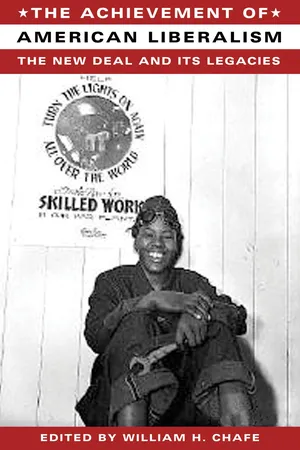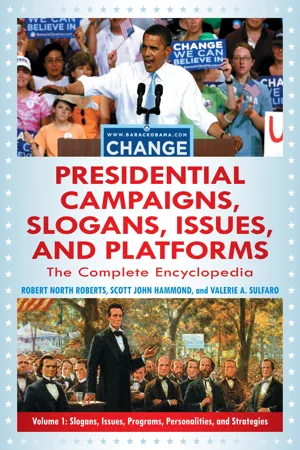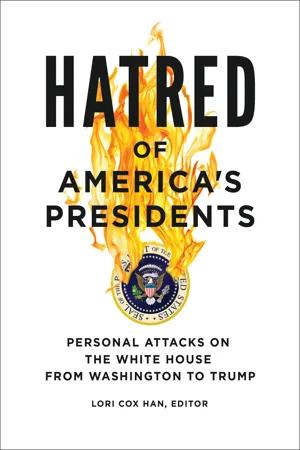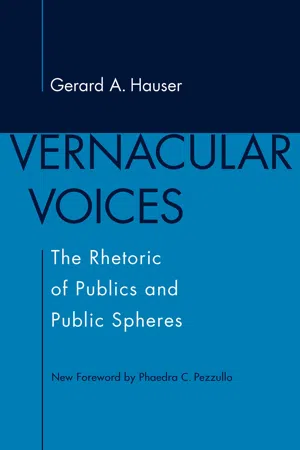History
1936 Presidential Election
The Presidential Election of 1936 in the United States saw incumbent President Franklin D. Roosevelt, a Democrat, win a landslide victory over Republican candidate Alf Landon. This election is notable for being one of the most lopsided in American history, with Roosevelt securing a second term in the midst of the Great Depression. His New Deal policies and popularity among working-class voters were key factors in his re-election.
Written by Perlego with AI-assistance
Related key terms
1 of 5
8 Key excerpts on "1936 Presidential Election"
- eBook - PDF
Voting Deliberatively
FDR and the 1936 Presidential Campaign
- Mary E. Stuckey(Author)
- 2015(Publication Date)
- Penn State University Press(Publisher)
introduction: roosevelt and the 1936 election A few short months before the election, the outcome seemed anything but certain. Both internal White House polls and the public polls conducted by the media supported the wide range of available anecdotal evidence: the presi- dent was in trouble. His first election, in the wake of a thoroughly discredited Republican administration, had once seemed to hold the promise of Demo- cratic dominance for the foreseeable future. But continuing economic prob- lems, a controversial domestic agenda, and a foreign policy that seemed weak and vacillating eroded the administration’s support among the mass public. The administration was attacked every day on the nation’s mass media and the president faced vicious and unrelenting criticism from both the Right and the Left, some of it aimed at his policies, much of it directed at the person of the president himself. Such criticism even escalated into the formation of a new political party dedicated, it appeared, exclusively to undermining the president and attacking his programs. From all the available evidence, then, it seemed unlikely that the president was about to make history. But his reelection was indeed historic. Franklin Delano Roosevelt won the 1936 election with nearly 61 percent of the vote, capturing forty-six of the forty- eight states, losing only in Maine and Vermont. Looking back at that result and knowing, as we do now, the entirety of the legacy left to us by FDR, it is easy to forget how contestable—and how contested—his administration actu- ally was. 1 It is also easy to overlook the innovations of that campaign and the consequences they had for the practices of American democracy. 2 This book 2 voting deliberatively examines that campaign with an eye toward understanding an underexam- ined moment in our national history and analyzing how the elements of that campaign reveal contemporary patterns in American elections as delibera- tive events. - eBook - ePub
- William D. Pederson(Author)
- 2011(Publication Date)
- Wiley-Blackwell(Publisher)
Chapter Five THE ELECTION OF 1932 Donald A. Ritchie The process of deciphering the 1932 election began as soon as the campaign had ended. It quickly became a truism that the Great Depression had doomed Herbert Hoover’s chances of reelection and paved the way for Franklin D. Roosevelt’s presidency. Less attention was therefore devoted to why Roosevelt won than on whether or not his campaign adequately prepared the nation for his New Deal agenda. By all accounts, the 1932 election marked a watershed in American politics. The Great Depression profoundly shook American voters, forcing them to reexamine their political allegiances and expectations for the federal government. After being the dominant political party since the Civil War, Republicans were dethroned and Democrats became the majority party for most of the next half century. Herbert Hoover, who had won the presidency in a landslide four years earlier, lost it in an even greater electoral avalanche. Franklin Roosevelt swept into the presidency promising a new deal for the American people. Democrats added 99 seats in the House and a dozen new senators to give them overwhelming control of Congress, and a readiness to follow the new president wherever he led, to get the nation out of the economic crisis. Citizens’ expectations for the federal government expanded and new programs more directly connected the government to their daily lives. The relevant literature began a year before the election when Ernest K. Lindley, a New York Herald Tribune reporter who covered Roosevelt as governor, published an influential campaign biography, Franklin D. Roosevelt: A Career in Progressive Democracy (1931: 7–8, 355). Lindley denied that Roosevelt had solicited him to write the book, but its sympathetic assessment helped to boost his candidacy. In a second edition, released after the election, Lindley added a chapter on the Democratic nomination, reminding readers that there had been nothing inevitable about that outcome - eBook - PDF
The Achievement of American Liberalism
The New Deal and Its Legacies
- William H. Chafe, William Chafe(Authors)
- 2002(Publication Date)
- Columbia University Press(Publisher)
The modern Democratic Party, observers agree with near unanimity, emerged from the trauma of the Great Depression. For a twenty-year mo-ment in history, beginning with Franklin Roosevelt’s landslide victory over Herbert Hoover in 1932, it dominated American politics and served as a ve-hicle for an enormous social transformation that was abetted by an un-precedented growth in the functions and institutional structure of the na-tional government. What with the Depression, World War II, the onset of the Cold War, and the social restructuring that accompanied these phe-nomena, it seems natural enough to call these two decades a watershed in American history. 1 The Democratic high tide, however, might equally be considered a peak in which a long-established political party, with a polyglot constituency and an amorphous policy direction, displayed unexpected resources to lead the American nation through one of the most critical periods of its history. The special character of this era in Democratic history is illustrated by a telling statistic: in 1932, Roosevelt was the party’s first candidate for president since Franklin Pierce (in 1852) to win more than 50 percent of the total popular vote. FDR would do it four times. Only two Democrats have managed it since—Lyndon Johnson in 1964 by an enormous margin and Jimmy Carter in 1976 by a scant half a percent. To an enormous degree, the Democratic success of the 1930s and 1940s was less a matter of national identity and or-ganizational strength than the personal charisma and strong leadership of one president—who in the end valued policy achievement over party. 2 HIGH TIDE: ROOSEVELT, TRUMAN, AND THE DEMOCRATIC PARTY, 1932–1952 Alonzo L. Hamby Begun in the 1790s as an alliance between southern agrarians and north-ern city politicians, the Democratic Party could locate both its greatest strength and greatest weakness in the diversity of its adherents. - eBook - ePub
Presidential Campaigns, Slogans, Issues, and Platforms
The Complete Encyclopedia [3 volumes]
- Robert North Roberts, Scott John Hammond, Valerie A. Sulfaro(Authors)
- 2012(Publication Date)
- Greenwood(Publisher)
Their confidence, events proved, was utterly justified. When the election came, the results were no less than stunning. Roosevelt shattered every electoral record, winning 28.7 million total popular votes, amounting to 60.8 percent of the entire popular vote cast (breaking the old record set by Warren Harding in 1920 and eventually exceeded by only one other election—Lyndon B. Johnson in 1964), and taking 523 electoral votes, or 98.5 percent (a percentage of the Electoral College exceeded only by George Washington and James Monroe before the rise of the modern two-party system and the broadening of the franchise), leaving Landon with just 8 electoral votes from two states, Vermont and Maine. Roosevelt’s margin of victory of 24 percent was the third highest in history (exceeded only by Harding in 1920 and Calvin Coolidge in 1924). Impressively, Roosevelt won at least 60 percent of the vote in 30 states. Landon’s approximately 16,700,000 votes represented around 38 percent of the electorate, the remaining votes going to the populist Union Party (their candidate, William Lemke of North Dakota winning just over 930,000 votes), the Socialist Party (campaign veteran Norman Thomas, in his third election, winning just under 188,000 votes, a poor showing for the Socialists who at one time enjoyed a promising position as a growing third party), and the Communist Party (scarcely managing 79,000 votes for their obscure candidate, Earl Browder).The diverse Roosevelt Coalition that was forged in the election of 1932, and somewhat foreshadowed in the Smith campaign of 1928, had not only held its base, but also expanded its reach. For the first time in history, for example, the majority (in this case, 71%) of voting African Americans cast their votes for a Democrat. More importantly, the New Deal programs that Roosevelt and the Democratic Congress established were earnestly embraced by a substantial majority of the American electorate, signaling that a dramatic change had indeed occurred and taken root in the way in which the role of the federal government was understood by the majority of American citizens. The 1930s would continue to be marked by hardship at home and ever-more menacing dangers abroad; but for the moment, Franklin Roosevelt was the most successful politician of his time, and the Democrats enjoyed unprecedented power throughout the federal government.Additional Resources
The American Presidency Project (http://www.presidency.ucsb.edu/ws/index.php?pid=29596#ixzz1IfGCKPvm ).Brands, H. W., Traitor to His Class: The Privileged Life and Radical Presidency of Franklin Roosevelt (New York: Doubleday, 2008).Brinkley, Alan, “1936,” in Arthur M. Schlesinger, Fred L. Israel, and David J. Frent, eds., Running for President: The Candidates and Their Images - eBook - ePub
A Third Term for FDR
The Election of 1940
- John Jeffries(Author)
- 2017(Publication Date)
- University Press of Kansas(Publisher)
1ROOSEVELT AND THE DEMOCRATS IN THE 1930S: TRIUMPH AND TROUBLESFrom 1930 to 1936, the Democratic Party went from success to success in national and state elections, with its landslide 1936 victory confirming the Democrats’ transformation from the nation’s minority party to its majority party. Roosevelt aimed to expand the New Deal in his second term, but he and his party met unexpected difficulties. A clumsy attempt to “pack” the Supreme Court, unpopular labor unrest, the “Roosevelt Recession” of 1937–1938 that sent economic indexes plunging, the rise of a conservative coalition in Congress comprising Republicans and conservative, largely Southern, Democrats, and the president’s effort to “purge” some leading conservative Democrats in 1938 party primaries all contributed to declining strength for Roosevelt in Washington and in the nation and to striking Republican gains in the 1938 midterm elections. By the late 1930s, moreover, German and Japanese aggression made international affairs and foreign policy far more important than they had been earlier in the decade, and war was declared in Europe in September 1939. The 1940 presidential election loomed, with Republicans resurgent, with both domestic and foreign policy sources of fierce debate, and with the parties’ presidential candidates to be selected.The Republican Party reigned as the nation’s usual majority party for some three decades following the realigning elections of the mid-1890s that had ended the tightly competitive politics of the Gilded Age. The Democrat Woodrow Wilson did win the presidency in 1912 and again in 1916 (though never with a majority of the popular vote), and the Democrats briefly controlled Congress in the Wilson years; but in the 1920s the Republicans reasserted their supremacy in national politics. In 1920, Warren G. Harding crushed the Democrat James M. Cox (and his vice-presidential running mate Franklin D. Roosevelt) with 60.3 percent of the popular vote; in 1924, Calvin Coolidge won 54 percent of the vote, far outpolling Democratic nominee John W. Davis’s 28.8 percent and Progressive Party nominee Robert M. La Follette’s 16.6 percent; and in 1928, Herbert C. Hoover swept to victory over Democrat Alfred E. (Al) Smith with 58.2 percent of the vote. Throughout the decade, Republicans held decisive margins in the House of Representatives and majorities in the Senate as well.1 Democrats did control the “Solid South,”2 - eBook - ePub
Farewell to the Party of Lincoln
Black Politics in the Age of F.D.R
- Nancy Joan Weiss, Nancy Weiss Malkiel(Authors)
- 2020(Publication Date)
- Princeton University Press(Publisher)
CHAPTER IX ◾ The Election of 1936The election of 1936 brought black Americans decisively into the Roosevelt coalition. Four years earlier, neither Republicans nor Democrats had made much effort to court blacks; and, although black voters disenchanted with Herbert Hoover had begun to break free from their Republican allegiance, deep-rooted wariness of the Democratic party had kept most blacks at least tentatively in the Republican camp. In 1936, with the political choices more clearcut, blacks joined the massive migration to the Democratic party.Proponents of splitting the black vote had argued in 1932 that a show of some independence and unpredictability on the part of the black electorate would make the major parties start bidding for black support. Nineteen thirty-six proved the point. For the first time, the black vote became part of the political story in the national press. Between the conventions and the election, the New York Herald Tribune assigned the black reporter, Earl Brown, to write a series of articles about it.1 “In no national election since 1860 have politicians been so Negro-minded,” Time reported. Newsweek remarked on “the new spectacle of national campaigners vying for Negro votes.”2 The phenomenon was so unusual that it was easy to exaggerate its significance; it was “obvious,” the New York Times correspondent, John Temple Graves, wrote, “that the Negro has become a tremendously important factor in national elections and that the parties from now on may be expected to vie in offers for his support.”3 The black press declared that the black vote would constitute the balance of power in a number of critical states. As the Pittsburgh Courier boasted, “Not as Maine goes, but as the Negro goes, will go the 1936 Presidential Election!"4These accounts clearly exaggerated the importance of the black vote—after all, blacks were disfranchised in the South and comprised only a small percentage of the eligible electorate in the North. Still, that percentage had grown significantly since 1930. The economic emergency further stimulated the migration of blacks from the South that had begun with the Great Migration of World War I and had continued in the 1920s. The Bureau of the Census estimated that 400,000 blacks left the South between 1930 and 1940. At the same time, there was an increase of 291,600 in the black population of eight northern states—Illinois, Indiana, Michigan, Missouri, New Jersey, New York, Ohio, and Pennsylvania—which accounted for 202 of the 523 electoral votes in 1936.5 As Table IX. 1 - eBook - ePub
Hatred of America's Presidents
Personal Attacks on the White House from Washington to Trump
- Lori Cox Han(Author)
- 2018(Publication Date)
- ABC-CLIO(Publisher)
Franklin Delano Roosevelt was born on January 30, 1882, in Hyde Park, New York. He married Eleanor Roosevelt (his fifth cousin, once removed) in 1905 and had six children, one of whom died in infancy. On April 12, 1945, at the age of 63, Roosevelt died of a massive cerebral hemorrhage while in Warm Springs, Georgia. On November 8, 1932, Roosevelt (also commonly known by his initials of FDR) was elected as the 32nd president of the United States, defeating the incumbent president, Herbert Hoover. In the 1932 election, Roosevelt won 472 electoral votes (57.4% of the popular vote) and carried all but six states. He would win reelection as president three more times. In 1936, he defeated Alf Landon decisively by winning 523 electoral votes, 60.8% of the popular vote, and all but two states. Roosevelt broke the two-term precedent in 1940 by defeating Republican nominee Wendell Wilkie, 57.4% to 44.8%. Although the popular vote was narrower that year than in his 1936 triumph, he comfortably won the Electoral College, 449–82, and carried all but ten states. Roosevelt’s final presidential campaign came in 1944, when he defeated Thomas Dewey by a slightly smaller margin than from four years previously, 53.4% to 45.9%. He won easily in the Electoral College, however, claiming 432 votes to Dewey’s 99 and carrying all but 12 states.A CONSEQUENTIAL PRESIDENCYMany Americans harbored passionate feelings about Roosevelt and his presidency—both positive and negative—because of the unparalleled length of his time in the Oval Office and because his policies made significant changes in how the United States addressed important matters of both domestic and foreign policy. The strongest base of opposition was probably among conservative southern Democrats, who saw Roosevelt’s progressive “New Deal” program as a short-term response to the Great Depression (with a return to the status quo once the crisis passed). Some of the more conservative senators like Harry Byrd and Carter Glass of Virginia, Cotton Ed Smith (South Carolina), and Millard Tydings (Maryland) soon realized, however, that Roosevelt’s plans would fundamentally change the country and their party in ways that they deeply opposed.Following significant policy defeats in 1937 and 1938, conservative Democrats were joined by Republicans who opposed much of Roosevelt’s domestic program. Some conservative critics even charged that under Roosevelt, communists were infiltrating all aspects of American life. This paranoia reached the point that the House of Representatives created the Committee on Un-American Activities in 1938 specifically to investigate the threat of communism in America. This committee was initially placed under the leadership of conservative representative Martin Dies (D-TX). Under his supervision, the committee eventually evolved into a weapon for conservatives to wield against the New Deal, which was depicted as making America more susceptible to communism. As the 1930s drew to a close, concerns about America’s role in the world provided another policy issue that would drive hatred of Roosevelt. Specifically, the nation struggled to reconcile its desire to help Europe resist fascism with the pull of isolationism. Underlying both of these broad lines of attack on Roosevelt was anti-Semitism, for many of Roosevelt’s critics believed that Jews exercised undue influence on the administration. Despite the hatred of some political elites, however, Roosevelt remained a generally popular political figure. - eBook - PDF
Vernacular Voices
The Rhetoric of Publics and Public Spheres
- Gerard A. Hauser(Author)
- 2022(Publication Date)
- University of South Carolina Press(Publisher)
234 Democracy's Narrative These letters form a text about hopes and fears, rights and duties, and dreams of a national future. I will examine them as a conversational text exploring the relationship between social actors and the state. We will see how the vernacular rhetoric that expresses a public opinion explores the evolving meaning of their society, the meaning of Roosevelt's America. Together they define a discursively constituted world shared by the people and a leader who is designated to decide. Moreover, their conversation may provide a vehicle for insight beyond that afforded by survey research into the dialogical possibilities between the governed and those who lead on the character of the world they inhabit. The Election of 1940 The 1940 presidential election was unprecedented in American histo-ry.3 For the first time voters were asked to consider a sitting president for a third term. The prohibition against a third term was not yet a constitution-al amendment; it was a legacy of American political tradition, dating from the nation's founding. George Washington, urged to continue in office, declined primarily due to age. Jefferson also declined after two terms, offer-ing more philosophical reasons in opposition. On the other hand, Jefferson had also expressed opposition to a president serving more than a single term, a principle that did not deter him from running for reelection. AndrewJackson made a similar case, arguing in his first six annual messages to Congress for a constitutional amendment changing the presidency to a single six-year term. Congress did not follow his recommendation nor did his principles prevent him from standing for a second term. However, he declined a third term bid for reasons of age and health. By the end ofJackson's administration, the tradition had been set that American presidents would sit for no more than two consecutive terms.
Index pages curate the most relevant extracts from our library of academic textbooks. They’ve been created using an in-house natural language model (NLM), each adding context and meaning to key research topics.
